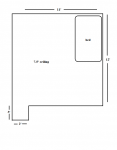superelixir
New member
Up until now, I've been recording and mixing in my bedroom, with no treatment. I know treatment is important, but the problem is that my room is so cluttered (with rectangular furniture against the walls creating more corners) that I feel treatment might be more trouble than it's worth. I know this is not at all an ideal set-up, so I've been looking for alternatives. There are two other options for me:
- Very small, empty room in the basement. Off the top of my head, it is ~7' x 9' (I will try to measure it later), and one of the shorter walls opens into a larger room. I could either cover this opening with a hanging door, or leave it open. The advantage to this room is that nobody uses it for anything, and it would be really easy for me to treat (less wall-space and no clutter). One downside is that it is really cold down there (or maybe it isn't a downside? but not the best for my instruments).
- Large room with tall ceiling. I don't know the dimensions, but it is also rectangular. Downsides are that I would not be able to treat it, and there is more ambient noise because the walls to the outside are not so thick. I'm thinking I could use this room if I want some natural reverb (the ceiling is over 20 feet high, slopes upward toward the middle), but since I can't get treatment for it, probably not a good place to set up.
My bedroom is small, or medium sized (don't know the dimensions, maybe 10' x 18'?) It is very cluttered with things, which makes it hard to spread out when I am recording, and makes it a problem to treat.
I am leaning towards the small room, but I would love to hear advice from you guys. Are there downsides to recording and mixing in such a small room? I am thinking that even with treatment, it might be hard to eliminate standing waves and choppy short delays...
- Very small, empty room in the basement. Off the top of my head, it is ~7' x 9' (I will try to measure it later), and one of the shorter walls opens into a larger room. I could either cover this opening with a hanging door, or leave it open. The advantage to this room is that nobody uses it for anything, and it would be really easy for me to treat (less wall-space and no clutter). One downside is that it is really cold down there (or maybe it isn't a downside? but not the best for my instruments).
- Large room with tall ceiling. I don't know the dimensions, but it is also rectangular. Downsides are that I would not be able to treat it, and there is more ambient noise because the walls to the outside are not so thick. I'm thinking I could use this room if I want some natural reverb (the ceiling is over 20 feet high, slopes upward toward the middle), but since I can't get treatment for it, probably not a good place to set up.
My bedroom is small, or medium sized (don't know the dimensions, maybe 10' x 18'?) It is very cluttered with things, which makes it hard to spread out when I am recording, and makes it a problem to treat.
I am leaning towards the small room, but I would love to hear advice from you guys. Are there downsides to recording and mixing in such a small room? I am thinking that even with treatment, it might be hard to eliminate standing waves and choppy short delays...


